Feast of Corpus Christi
The Feast of Corpus Christi (Ecclesiastical Latin: Dies Sanctissimi Corporis et Sanguinis Domini Iesu Christi, lit. 'Day of the Most Holy Body and Blood of Jesus Christ the Lord'), also known as the Solemnity of the Most Holy Body and Blood of Christ,[1] is a Christian liturgical solemnity celebrating the Real Presence of the Body and Blood, Soul and Divinity of Jesus in the elements of the Eucharist; it is observed by the Latin Church, in addition to certain Western Orthodox, Lutheran, and Anglican churches. Two months earlier, the institution of the Eucharist at the Last Supper is observed on Maundy Thursday in a sombre atmosphere leading to Good Friday. The liturgy on that day also commemorates Christ's washing of the disciples' feet, the institution of the priesthood, and the agony in the Garden of Gethsemane.
| Solemnity of The Most Holy Body and Blood of Christ | |
|---|---|
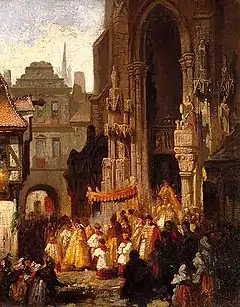 Corpus Christi procession. Oil on canvas by Carl Emil Doepler. | |
| Official name | Solemnity of the Most Holy Body and Blood of Christ |
| Also called | Corpus Domini |
| Observed by | as a public holiday in Austria, Brazil, Bolivia, Bosnia and Herzegovina, Colombia, Croatia, Dominican Republic, Haiti, East Timor, Equatorial Guinea, parts of Germany, Grenada, Liechtenstein, Malta, Mexico, Monaco, Panama, Peru, Poland, Portugal, Philippines, Saint Lucia, San Marino, parts of Spain, parts of Switzerland, Trinidad and Tobago |
| Date | Thursday after Trinity Sunday; 60 days after Easter, or the Sunday immediately following this |
| 2022 date | June 16 |
| 2023 date | June 8 |
| 2024 date | May 30 |
| 2025 date | June 19 |
| Frequency | annual |

The feast of Corpus Christi was proposed by Thomas Aquinas, Doctor of the Church, to Pope Urban IV, in order to create a feast focused solely on the Holy Eucharist, emphasizing the joy of the Eucharist being the Body and Blood, Soul and Divinity of Jesus Christ. Having recognized in 1264 the authenticity of the Eucharistic Miracle of Bolsena, on input of Aquinas,[2] the pontiff, then living in Orvieto, established the feast of Corpus Christi as a Solemnity and extended it to the whole Roman Catholic Church.[3][4]
The feast is liturgically celebrated on the Thursday after Trinity Sunday or, "where the Solemnity of The Most Holy Body and Blood of Christ is not a holy day of obligation, it is assigned to the Sunday after the Most Holy Trinity as its proper day".[5]
At the end of Holy Mass, there is often a procession of the Blessed Sacrament, generally displayed in a monstrance. The procession is followed by the Benediction of the Blessed Sacrament.[6] A notable Eucharistic procession is that presided over by the Pope each year in Rome, where it begins at the Archbasilica of St. John Lateran and passes to the Basilica of Saint Mary Major, where it concludes with the aforementioned Benediction. Corpus Christi wreaths, which are made of flowers, are hung on the doors and windows of the Christian faithful, in addition to being erected in gardens and fields.[6]
The celebration of the feast was suppressed in Protestant churches during the Reformation for theological reasons: outside Lutheranism, which maintained the confession of the Real Presence, many Protestants denied the real presence of Christ in the Eucharist other than as a merely symbolic or spiritual presence. Today, most Protestant denominations do not recognize the feast day,[7] with exception of certain Lutheran churches and the Church of England, the latter of which abolished it in 1548 as the English Reformation progressed, but later reintroduced it.[8] Some Anglican churches now observe Corpus Christi, sometimes under the name Thanksgiving for Holy Communion.
History
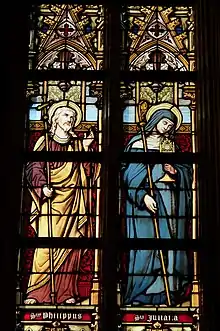
The institution of Corpus Christi as a feast in the Christian calendar resulted from approximately forty years of work on the part of Juliana of Liège, a 13th-century Norbertine canoness, also known as Juliana de Cornillon, born in 1191 or 1192 in Liège, Belgium, a city where there were groups of women dedicated to Eucharistic worship. Guided by exemplary priests, they lived together, devoted to prayer and to charitable works. Orphaned at the age of five, she and her sister Agnes were entrusted to the care of the Augustinian nuns at the convent and leprosarium of Mont-Cornillon, where Juliana developed a special veneration for the Blessed Sacrament.[9]
She always longed for a feast day outside of Lent in its honour. Her vita reports that this desire was enhanced by a vision of the church under the appearance of the full moon having one dark spot, which signified the absence of such a solemnity.[10][11] In 1208, she reported her first vision of Christ in which she was instructed to plead for the institution of the feast of Corpus Christi. The vision was repeated for the next 20 years but she kept it a secret. When she eventually relayed it to her confessor, he relayed it to the bishop.[12]
Juliana also petitioned the learned Dominican Hugh of St-Cher, and Robert de Thorete, Bishop of Liège. At that time bishops could order feasts in their dioceses, so Bishop Robert ordered in 1246 a celebration of Corpus Christi to be held in the diocese each year thereafter on the Thursday after Trinity Sunday.[13][14][15] The first such celebration occurred at St Martin's Church in the city that same year.
Hugh of St-Cher travelled to Liège as Cardinal-Legate in 1251 and, finding that the feast was not being observed, reinstated it. In the following year, he established the feast for his whole jurisdiction (Germany, Dacia, Bohemia, and Moravia), to be celebrated on the Thursday after the Octave of Trinity (one week later than had been indicated for Liège), but with a certain elasticity, for he granted an indulgence for all who confessed their sins and attended church "on a date and in a place where [the feast] was celebrated".[16]
Jacques Pantaléon of Troyes was also won over to the cause of the Feast of Corpus Christi during his ministry as Archdeacon in Liège under the diocesan bishop Robert of Thourotte. It was he who, having become Pope as Urban IV in 1264, instituted the Solemnity of Corpus Christi on the Thursday after Pentecost as a feast for the entire Latin Church, by the papal bull Transiturus de hoc mundo.[9][16] The legend that this act was inspired by a procession to Orvieto in 1263, after a village priest in Bolsena and his congregation witnessed a Eucharistic miracle of a bleeding consecrated host at Bolsena,[15] has been called into question by scholars who note problems in the dating of the miracle, whose tradition begins in the 14th century, and the interests of Urban IV, a former Archdeacon in Liège.
Though this was the first papally imposed universal feast for the Latin Church,[17] it was not widely celebrated for half a century. It was adopted by a number of dioceses in Germany and by the Cistercians, and in 1295 was celebrated in Venice.[18] It became a truly universal feast only after the bull of Urban IV was included in the collection of laws known as the Clementines, compiled under Pope Clement V, but promulgated only by his successor Pope John XXII in 1317.[18][19]
While the institution of the Eucharist is celebrated on Holy (Maundy) Thursday, the liturgy on that day also commemorates Christ's washing of the disciples' feet, the institution of the priesthood and the agony in the Garden of Gethsemane. So many other functions took place on this day that the principal event was almost lost sight of. This is mentioned in the Bull Transiturus as the chief reason for the introduction of the new feast. Hence, the feast of Corpus Christi was established to create a feast focused solely on the Holy Eucharist.[10]
Three versions of the office for the feast of Corpus Christi in extant manuscripts provide evidence for the Liège origins and voice of Juliana in an original office, which was followed by two later versions of the office. A highly sophisticated and polished version can be found in BNF 1143, a musical manuscript devoted entirely to the feast, upon which there is wide scholarly agreement: the version in BNF 1143 is a revision of an earlier version found in Prague, Abbey of Strahov MS D.E.I. 7, and represents the work of Thomas Aquinas following or during his residency at Orvieto from 1259 to 1265. The office can also be found in the 1343 codex Regimen Animarum.[20]: 13 This liturgy may be used as a votive Mass of the Blessed Sacrament on weekdays in ordinary time.[21] The hymn Aquinas composed for Vespers of Corpus Christi, Pange Lingua or another eucharistic hymn, is also used on Maundy Thursday during the procession of the Blessed Sacrament to the altar of repose.[22]
The last two verses of Pange Lingua are also used as a separate hymn, Tantum Ergo, which is sung at Benediction of the Blessed Sacrament. O Salutaris Hostia, another hymn sung at Benediction of the Blessed Sacrament, comprises the last two verses of Verbum Supernum Prodiens, Aquinas' hymn for Lauds of Corpus Christi. Aquinas also composed the propers for the Mass of Corpus Christi, including the sequence Lauda Sion Salvatorem. The epistle reading for the Mass was taken from Paul's First Epistle to the Corinthians (1 Corinthians 11:23–29), and the Gospel reading was taken from the Gospel of John (John 6:56–59).

When Pope Pius V revised the General Roman Calendar (see Tridentine Calendar), Corpus Christi was one of only two "feasts of devotion" that he kept, the other being Trinity Sunday.[23] In that calendar, Corpus Christi was celebrated on the Thursday after Trinity Sunday.[24] The feast had an octave until 1955, when Pope Pius XII suppressed all octaves, even in local calendars, except those of Christmas, Easter and Pentecost (see General Roman Calendar of Pope Pius XII).
From 1849 until 1969, a separate Feast of the Most Precious Blood of Our Lord Jesus Christ was assigned originally to the first Sunday in July, later to the first day of the month. This feast was removed from the General Roman Calendar in 1969, "because the Most Precious Blood of Christ the Redeemer is already venerated in the solemnities of the Passion, of Corpus Christi and of the Sacred Heart of Jesus and in the feast of the Exaltation of the Holy Cross. But the Mass of the Most Precious Blood of Our Lord Jesus Christ is placed among the votive Masses".[25]
Celebration
Roman Catholic Church
The feast of Corpus Christi is one of five occasions in the year on which a diocesan bishop is not to be away from his diocese unless for a grave and urgent reason.[26]
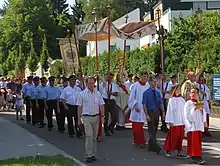
In many countries, the day is a holy day of obligation to participate in the celebration of Mass and takes place on the Thursday after Trinity Sunday. On that day or on the following Sunday, which is the feast day where it is not a holy day of obligation, it is traditional to hold in the streets of a town or in an individual parish a procession with prayers and singing to honor the Blessed Sacrament. During the procession, the consecrated host is displayed in a monstrance held aloft by a member of the clergy. At the end of the procession, Benediction of the Blessed Sacrament is imparted.[27]
Anglicanism
The celebration of Corpus Christi was abolished in England in 1548.[28][29] However, in the Church of England "the Thursday after Trinity Sunday may be observed as The Day of Thanksgiving for the Institution of Holy Communion (Corpus Christi)" as one of the church's Festivals and with a special liturgy.[30]
The feast is also celebrated by Anglo-Catholic parishes, even in provinces of the Anglican Communion that do not officially include it in their calendars. McCausland's Order of Divine Service, the most commonly used ordo in the Anglican Church of Canada, provides lections for the day.
Other churches
Corpus Christi is also celebrated by the Old Catholic Church, the Liberal Catholic Church and by some Western Rite Orthodox Christians. It is commemorated in the liturgical calendars of the more Latinized Eastern Catholic Churches.
Lutheranism
Martin Luther spoke out against processing with the consecrated elements, which he viewed as "only play-acting" and "just vain idolatry". In one of his postils (homilies), he wrote
I am to no festival more hostile … than this one. Because it is the most shameful festival. At no festival are God and his Christ more blasphemed, than on this day, and particularly by the procession. For then people are treating the Blessed Sacrament with such ignominy that it becomes only play-acting and is just vain idolatry. With its cosmetics and false holiness it conflicts with Christ's order and establishment. Because He never commanded us to carry on like this. Therefore, beware of such worship![31]
However, the feast was retained in the calendars of the Lutheran Church until about 1600.[32]
Calvinism
Like Lutherans, followers of the Reformed tradition do not observe the feast.[33]
Folk traditions
On the eve of the Feast of Corpus Christi, clergy bless Corpus Christi wreaths that are made of flowers.[6] Corpus Christi wreaths and bouquets are often "attached to flags and banners, to houses, and to the arches of green boughs that span the streets."[6] In Christian homes, these Corpus Christi wreaths are suspended on walls or displayed on doors and in windows.[6] Corpus Christi wreaths are also "put up in gardens, fields, and pastures, with a prayer for protection and blessing upon the growing harvest."[6]
Throughout Christendom, "the custom developed of carrying the Blessed Sacrament in a splendid procession through the town after the Mass on Corpus Christi Day."[6] The monstrance which holds the host is surrounded by a Corpus Christi wreath of flowers.[6] During the procession, church bells are rung and "the faithful kneel in front of their homes to adore the Eucharistic Lord."[6] Along the route in which the procession occurs, Christian homes "are decorated with little birch trees and green boughs", with candles being lit in the windows.[6] Oftentimes, stops are made at various points called "stations" during the procession and "the Blessed Sacrament is put on an altar table" while a Gospel passage is read and hymns are sung, along with prayer being made.[6]
Brasil and Portugal
Street carpets for the Feast of Corpus Christi (Portuguese: Tapetes de Corpus Christi) are made of different materials like coffee grounds, flowers, sand, salt.[34]
Croatia
In Croatian language, there are various names for the Feast: Brašančevo (after hypocorism brašance of the noun brašno, meaning "flour"; dating from 18th century and used in Požega area,[35] Otok, Varoš,[36] Sikirevci[37] and southern Baranja,[38] Luč, as well among Croats of Vojvodina and Herzegovina[39]) with variations (Brošančevo, Brešančevo),[40] Korosante (from Latin Corpo Sancto; used in Dubrovnik area and Pelješac),[41][42] Božji dan (Božji don; literally "Lord's Day") and Božji blagdan (lit. "Lord's/God's Feast").[40]
England
In medieval times in many parts of Europe, Corpus Christi was a time for the performance of mystery plays. The plays in York, England, were performed on Corpus Christi Day for some 200 years until their suppression in the sixteenth century during the Protestant Reformation.[43]
Peru
In the southern highlands of the Cusco Region of Peru, the festival of Quyllurit'i is held near Corpus Christi in the Sinaqara Valley. As many as 10,000 pilgrims come from neighboring areas. Culminating on Trinity Sunday, this festival marks the return in the sky of the Pleiades constellation, known in the Quechua language as Qullqa, or "storehouse", as it is associated with the upcoming harvest and New Year. The festival precedes the official feast of Corpus Christi, held the Thursday following Trinity Sunday, but it is closely associated with it.[44]
Poland
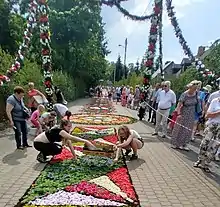
In Spycimierz in central Poland (Gmina Uniejów), parishioners arrange a carpet of live flowers about one kilometre long. A solemn procession passes over it at 5 pm. [45] Long carpets of flowers are also laid in four parishes in the Opole Voivodship in southern Poland. Flower carpets tradition for Corpus Christi processions was inscribed on the UNESCO Representative List of the Intangible Cultural Heritage of Humanity in 2021. [46]
Andalucia
The celebrations in Seville are depicted in a section of Iberia, the masterpiece of the composer Albéniz.
Castile-La Mancha
Corpus Christi is one of the main festivals in Toledo, Spain.
Castile and León
In the village of Castrillo de Murcia near Burgos, the celebration includes the practice of El Colacho (baby jumping).[47]
Catalonia
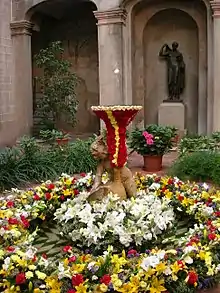

In Catalonia, Corpus Christi is celebrated with the tradition of the dancing egg. There is evidence this tradition dates from the 16th century.[48]
The Patum de Berga is a popular and traditional festival that is celebrated each year in the Catalan city of Berga (Barcelona) during Corpus Christi. It consists of a series of "dances" (balls) by townspeople dressed as mystical and symbolical figures. The balls are marked by their solemnity and their ample use of fire and pyrotechnics. It was declared a Traditional Festival of National Interest by the Generalitat de Catalunya in 1983, and as a Masterpiece of the Oral and Intangible Heritage of Humanity by UNESCO in 2005.[49]
Date
Corpus Christi is a moveable feast, celebrated on the Thursday after Trinity Sunday,[10] 60 days after Easter, or, in countries where it is not a holy day of obligation, on the following Sunday.[50]
The earliest possible Thursday celebration falls on May 21 (as in 1818 and 2285), the latest on June 24 (as in 1943 and 2038). The Sunday celebration of the feast, introduced in the second half of the 20th century, occurs three days later, between May 24 at earliest (for the first time in 2285) and June 27 at latest (for the first time in 2038). For Western Rite Orthodox Christians, since they use the Julian Calendar, at least for all Feast Days dependent on the date of Pascha, their date of the celebration of Corpus Christi, translates to, in the Gregorian Calendar, from June 3 at the earliest, to July 7, at the latest.
Corpus Christi is a public holiday in some countries with a predominantly Catholic population including, among others, Argentina, Austria, Bolivia, parts of Bosnia and Herzegovina, Brazil, Colombia, Croatia,[51] Dominican Republic, East Timor, Equatorial Guinea, parts of Germany, Grenada, Haiti, Jerusalem in Israel, Liechtenstein, Monaco, Paraguay, Peru, Poland, Portugal, parts of Puerto Rico, Saint Lucia, San Marino, Spain, parts of Switzerland, Trinidad and Tobago, parts of the United States, and Venezuela.
- 2019 - June 20 (Sunday observance: June 23)
- 2020 - June 11 (Sunday observance: June 14)
- 2021 - June 3 (Sunday observance: June 6)
- 2022 - June 16 (Sunday observance: June 19)
- 2023 - June 8 (Sunday observance: June 11)
- 2024 - May 30 (Sunday observance: June 2)
- 2025 - June 19 (Sunday observance: June 22)
- 2026 - June 4 (Sunday observance: June 7)
- 2027 - May 27 (Sunday observance: May 30)
See also
Literature
- Dragić, Marko (2019). "Tijelovo u hrvatskoj katoličkoj crkveno-pučkoj kulturnoj baštini" [The Feast of Corpus Christi in Croatian Catholic Church-Folk Cultural Heritage]. Crkva U Svijetu. 54 (1): 59–81. doi:10.34075/cs.54.1.4. S2CID 189152720.
References
- "Solemnity of the Most Holy Body and Blood of Christ". Catholic News Agency. Archived from the original on 21 June 2019. Retrieved 21 June 2019.
- "The Eucharistic Miracle of Bolsena (Orvito, Italy)". therealpresence.org. Archived from the original on 11 January 2001. Retrieved 21 June 2019.
- Robert E. Alexander; John A. Elliott (1 April 2018). Livio Orazio Valentini: An Artist's Spiritual Odyssey. University of South Carolina Press. p. 43. ISBN 9781611178999. OCLC 1019855530. Archived from the original on 21 June 2019. Retrieved 21 June 2019.
- "Italy's Orvieto miracle inspires thousands during jubilee". Rome. 7 October 2013. Archived from the original on 7 October 2013. Retrieved 21 June 2019.
- "Sanctissimi Corpus et Sanguis Christi." Roman Missal, 2011 Latin to English translation
- Weiser, Francis X. (1956). The Holyday Book. Harcourt, Brace and Company. p. 57.
- "Corpus Christi, Feast of". Encyclopædia Britannica. 1974.
- "Corpus Christi at Cyberbrethren". Redeemer Lutheran Church. 17 June 2006. Archived from the original on 18 July 2011. Retrieved 13 June 2022.
- "Benedict XVI. "St. Juliana: the Nun Who Gave Us the Feast of Corpus Christi", general audience address of Nov. 17, 2010, which he dedicated to St. Juliana". Zenit.org. 30 May 2013. Retrieved 23 January 2014.
- "Mershman, Francis. "Feast of Corpus Christi." The Catholic Encyclopedia. Vol. 4. New York: Robert Appleton Company, 1908. 17 Jun. 2013". Newadvent.org. Retrieved 23 January 2014.
- Vie de Sainte Julienne de Cornillon, edited by J.-P. Delville, Published by the Institute of Medieval Studies at the Catholic University at Louvain, pp. 120–123
- Phyllis Jestice, Holy people of the world Published by ABC-CLIO, 2004 ISBN 1-57607-355-6 p. 457
- Barbara R. Walters, The Feast of Corpus Christi (Penn State Press 2006 ISBN 978-0-271-04831-4), p. 9
- The decree is preserved in Anton Joseph Binterim, Vorzüglichsten Denkwürdigkeiten der Christkatholischen Kirche (Mainz, 1825–41), together with parts of the first liturgy written for the occasion.
- Chisholm, Hugh, ed. (1911). . Encyclopædia Britannica. Vol. 7 (11th ed.). Cambridge University Press. p. 193.
- Walters (2006), p. 12
- Oxford History of Christian Worship By Geoffrey Wainwright, Oxford University Press 2006 ISBN 0-19-513886-4, p. 248
- Miri Rubin, Corpus Christi: The Eucharist in Late Medieval Culture (Cambridge University Press 1991 ISBN 978-0-52143805-6), pp. 181–182
- Walters (2006), p. 13
- Mathiesen, Thomas J. (Winter 1983). ""The Office of the New Feast of Corpus Christi" in the Regimen Animarum at Brigham Young University". The Journal of Musicology. 2 (1): 13–44. doi:10.2307/763576. JSTOR 763576.
- General Instruction of the Roman Missal, 375
- Roman Missal, Mass of the Lord's Supper, 38
- Calendarium Romanum (Libreria Editrice Vaticana 1969), p. 66
- Manlio Sodi, Achille Maria Triacca (editors), Missale Romanum: Editio Princeps (1570) (Libreria Editrice Vaticana 1998 ISBN 978-88-209-2547-5), pp. 399–401
- Calendarium Romanum (Libreria Editrice Vaticana 1969), p. 128
- Code of Canon Law, canon 395 §3
- "Katinas, Paula. "Brooklyn's Catholic churches celebrate Feast of Corpus Christi"". Brooklyneagle.com. 3 June 2013. Retrieved 23 January 2014.
- King, John N., ed. (2004). Voices of the English Reformation: A Sourcebook. University of Pennsylvania Press. p. 181. ISBN 9780812200805.
- Rogerson, Margaret (2011). The York Mystery Plays: Performance in the City. York Medieval Press. ISBN 9781903153352.
- The Church of England: Festivals
- Luther Martin: Auslegung von Joh 6. 1530, Kirchenpostille 1521, Tischreden
- Frank Senn: Christian Liturgy: Catholic and Evangelical, Fortress Press, 1997. p. 344. ISBN 0-8006-2726-1
- "Protestant Sacred Space". 4 April 2017.
- Fiéis montam 4 km de tapete em São Gonçalo
- Dragić 2019, p. 64.
- Lukić, Luka. "Varoš. Narodni život i običaji". Zbornik za narodni život i običaje. Zagreb. XXV: 298.
- Marković, Josip (1986). Običajnik župe Sikirevci. Sikirevci. p. 77.
{{cite book}}: CS1 maint: location missing publisher (link) - Sekereš, Stjepan (1977). "Govor Hrvata u južnoj Baranji". Hrvatski dijalektološki zbornik. Zagreb. 4: 426.
- Vulić, Sanja (2016). "Blagdani i spomendani u zapisima Josipa Lovretića (pučka imena, nazivlje, poslovice i uzrečice)" [Holidays and remembrance days in Josip Lovretić's writings (folk names, terminology, proverbs and sayings)]. Folia onomastica Croatica. 25: 186. doi:10.21857/mzvkptx7d9.
- "Danas je Tijelovo. Znate li što zapravo obilježavamo ovim blagdanom?". Večernji list. 20 June 2019.
- Dragić 2019, p. 65.
- "Danas su Korosante, znate li zašto su za Dubrovnik posebno važne?". Dubrovački dnevnik. 8 June 2023.
- Beadle, Richard; King, Pamela M (1999). York Mystery Plays: A Selection in Modern Spelling. Oxford University Press. ISBN 0-19-283710-9.
- Antoinette Molinié Fioravanti, Celebrando el Cuerpo de Dios (Corpus Christi Festival), Fondo Editorial PUCP, 1999, pp. 197–198(in Spanish)
- "History of the tradition".
- "Elements inscribed in 2021 on the Representative List of the Intangible Cultural Heritage of Humanity" https://ich.unesco.org/en/RL/flower-carpets-tradition-for-corpus-christi-processions-01743
- "Spanish village holds baby jump". bbc.co.uk. BBC News – Europe. 25 May 2008.
- VilaWeb TV: L'Ou com Balla a Ca l'Ardiaca (in Catalan)
- info at UNESCO.org
- "What is the Feast of Corpus Christi? | YOUCAT".
- Zakon o blagdanima, spomendanima i neradnim danima u Republici Hrvatskoj Narodne novine. Published 14 November 2019. Archived in Croatian Web Archive (HAW).
External links
- Corpus Christi, with order for procession at www.therealpresence.org
- Feast of Corpus Christi: History
- Carthusians and Corpus Christi
- Corpus Christi background, from www.haverford.edu
- Traditional Corpus Christi celebrations in Panama
- Thomas M Landy, "Feasts, Processions & Festivals", Catholics & Cultures updated 12 June 2017
